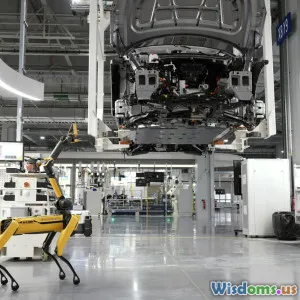
Enhancing Road Safety with Vehicle Technology
5 min read Explore how modern vehicle technologies are transforming road safety and reducing accidents. (0 Reviews)
Enhancing Road Safety with Vehicle Technology
Road safety remains a paramount concern worldwide, with millions of accidents occurring each year resulting in injuries and fatalities. Fortunately, recent advancements in vehicle technology are paving the way for safer roads. This article delves into how innovations such as advanced driver-assistance systems (ADAS), artificial intelligence (AI), and the Internet of Things (IoT) are transforming vehicle safety and enhancing the overall driving experience.
The Rise of Advanced Driver-Assistance Systems (ADAS)
ADAS are systems built into vehicles that provide various safety features designed to assist the driver. These technologies include adaptive cruise control, lane-keeping assist, automatic emergency braking, and blind-spot detection. By providing real-time feedback and intervention, ADAS significantly reduces the likelihood of human error, which is a leading cause of traffic accidents.
Real-World Impact of ADAS
According to a study by the National Highway Traffic Safety Administration (NHTSA), vehicles equipped with advanced driver-assistance features can reduce crashes by up to 40%. For instance, automatic emergency braking systems can prevent or mitigate the severity of collisions by detecting obstacles in the vehicle's path and applying brakes when necessary.
Artificial Intelligence in Vehicle Safety
AI is revolutionizing the automotive industry, particularly in enhancing road safety. Machine learning algorithms analyze vast amounts of data collected from vehicle sensors, cameras, and external sources to help predict and prevent accidents.
AI-Powered Safety Features
-
Predictive Maintenance: AI analyzes vehicle performance data to predict potential failures before they occur, thus preventing accidents caused by mechanical issues.
-
Traffic Pattern Recognition: AI systems can interpret traffic patterns and adjust vehicle behavior accordingly, improving safety in crowded urban environments.
-
Driver Monitoring Systems: These systems use AI to track driver behavior, alerting them if they show signs of drowsiness or distraction, thereby enhancing overall safety.
The Role of IoT in Vehicle Safety
The IoT connects vehicles to each other and the surrounding infrastructure, creating a network that enhances safety through real-time data exchange. This connectivity allows for smart traffic management and communication between vehicles, which can significantly reduce the risk of accidents.
Examples of IoT Enhancements
- Vehicle-to-Vehicle (V2V) Communication: This technology allows vehicles to communicate with one another about their speed, location, and direction, helping to prevent collisions.
- Vehicle-to-Infrastructure (V2I) Communication: Vehicles can exchange information with traffic signals and road signs to optimize traffic flow and reduce accident risks.
The Future of Road Safety
As vehicle technology continues to evolve, the future looks promising for road safety. With advancements in autonomous vehicles, we are nearing a point where driver error could be virtually eliminated. Fully autonomous vehicles equipped with cutting-edge technology could navigate roads safely without human intervention, drastically reducing accident rates.
Conclusion
In conclusion, enhancing road safety through vehicle technology is not just a dream but a rapidly approaching reality. By leveraging advanced driver-assistance systems, artificial intelligence, and the Internet of Things, we are paving the way for safer roads. As these technologies become more prevalent, we can expect to see a significant decline in traffic accidents, making our roads safer for everyone. Embracing these innovations will be key to ensuring a safer driving environment for future generations.
Rate the Post
User Reviews
Popular Posts





















